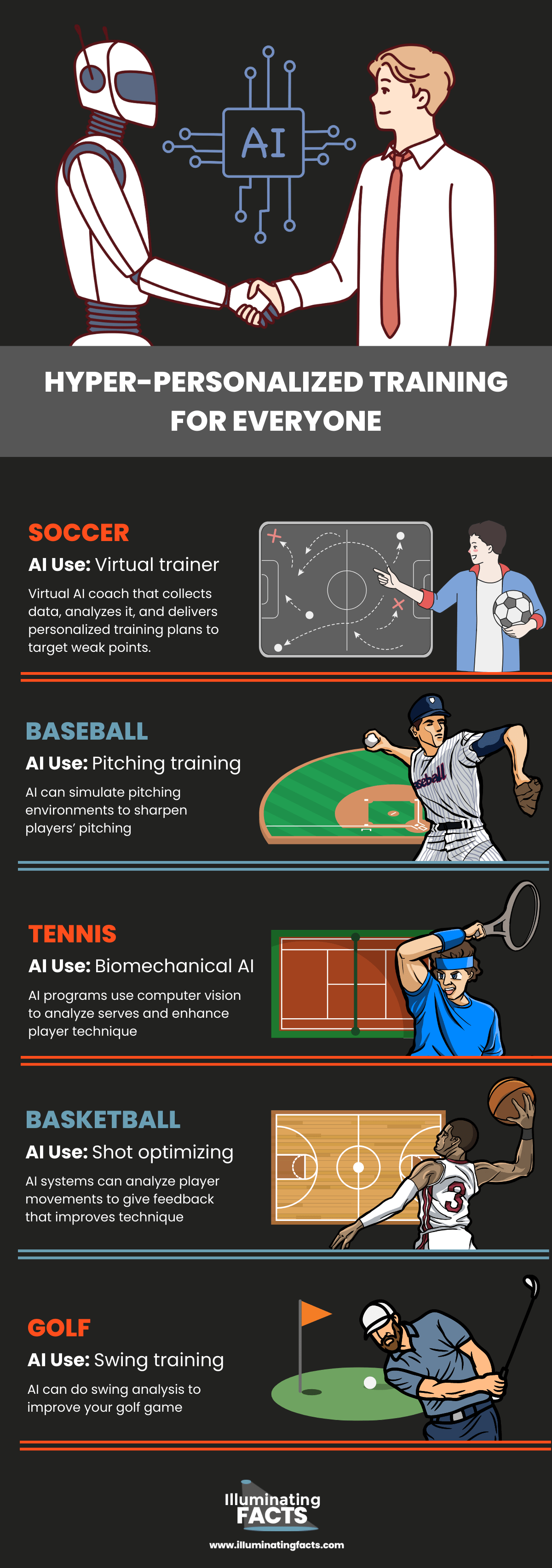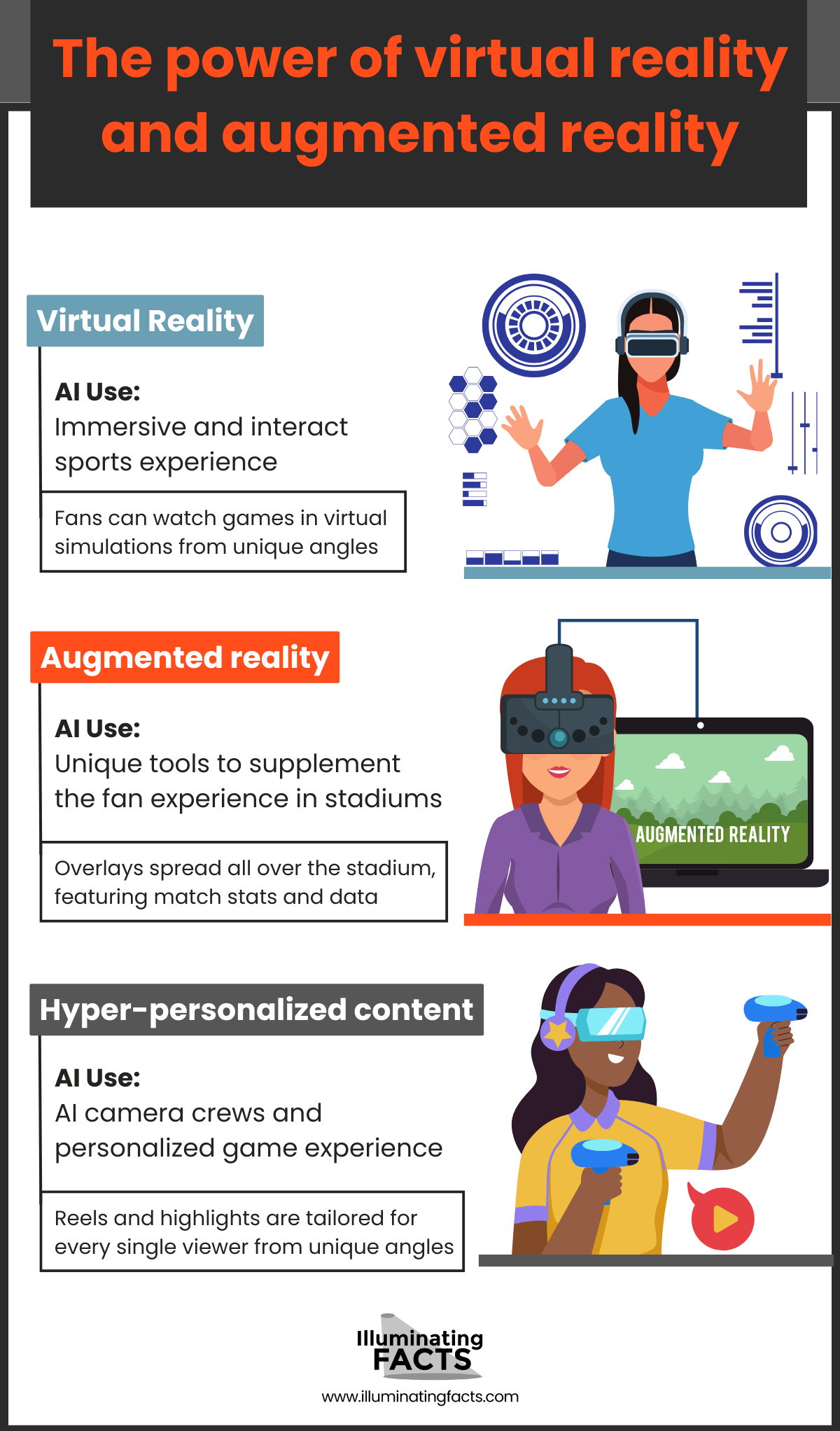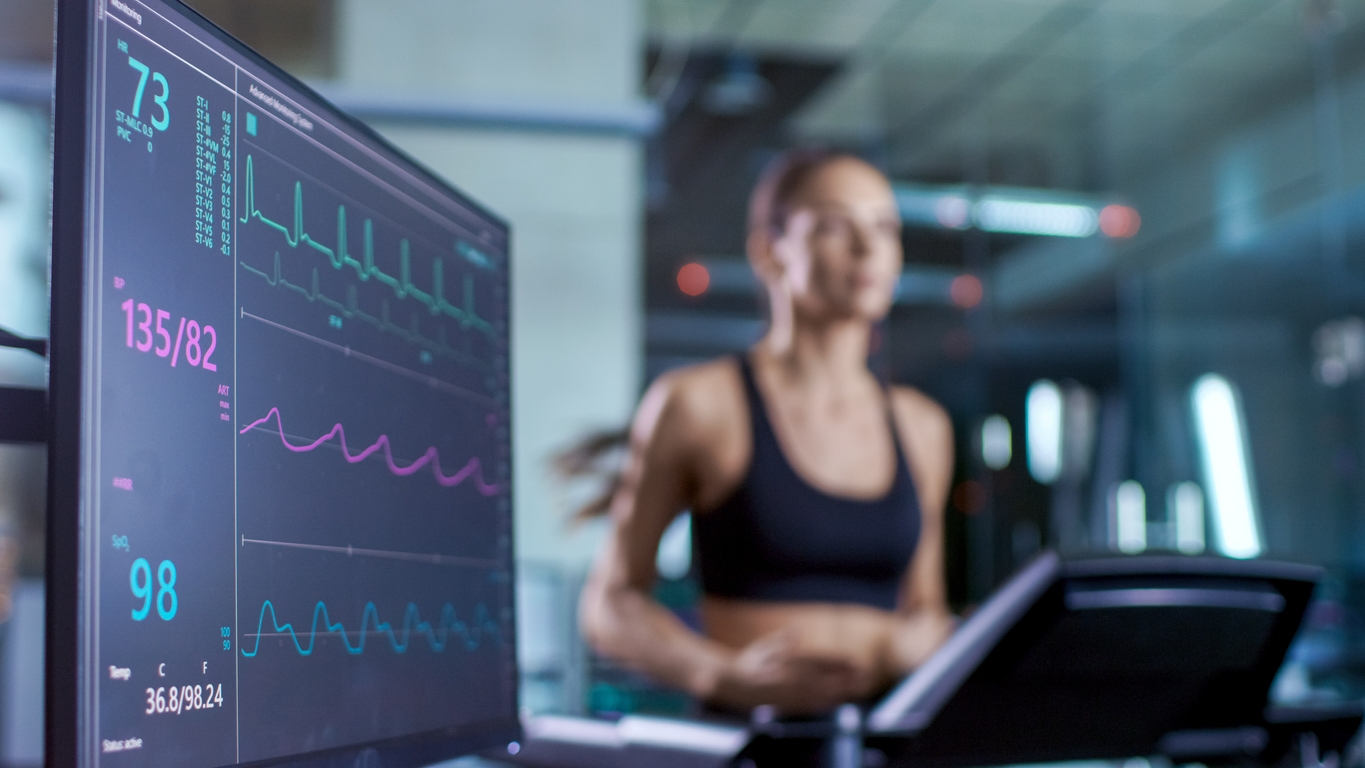As AI continues to rise meteorically across industries, sports is next in line for a radical transformation. And it’s already making big waves in the industry. Imagine perfecting your tennis serve by playing against a virtual coach who learns from your behavior and adapts to your level. Or, a future where the NBA uses AI to scout talent. Could stadiums stream VR with hyper-personalized stats and angles? The answer is yes. And all three technologies are already here.
AI is redefining sports and athletics. And some exciting changes are coming soon. We’ll explore them in this article. And we’ll dive into how it’s transforming training for athletes, team strategy, and how we experience sports.
Your personal virtual coach
Collects data 24/7
The next generation of fitness health monitoring is personalized training programs. Meet WHOOP. WHOOP is a wearable band that collects biometric data 24/7. [1] It has no screen. It doesn’t ring any notifications. It just collects data until its 5-day battery life runs out. And the data is run through AI to craft the perfect training program for you. It alerts you to your stress levels, early signs of injury, or even fatigue.
Athletes from NFL, NBA and other big leagues wear these band monitors. Since 2022, NBA, in partnership with Fusion Sport, is providing sensors designed to reduce injury risk. [2] And sports are adopting it widely — from elite teams to high school. It also recommends ideal recovery regimens. Lower risk of injuries helps an athlete’s career longevity.
Hyper-personalized training for everyone
Training programs are no longer one-size-fits-all templates that have become standard over the decades. Coaches now have a powerful tool to accelerate skill development and guide players with AI-crafted training programs.
VR simulations are providing close-to-realistic practice for every major sport. [3] You can now perfect your tennis serves while being trained with a virtual master coach.
The tech is also opening new doors for amateur athletes. Even if they do not have access to expensive coaches and elite training, they can use smart wearables and AI coaches to receive highly effective insights. You can imagine generative AI that can generate fictitious matches between popular teams after you input specific conditions or plays.
Sport | AI Use | Details |
Soccer | Virtual trainer | Virtual AI coach that collects data, analyzes it, and delivers personalized training plans to target weak points. |
Baseball | Pitching training | AI can simulate pitching environments to sharpen players’ pitching |
Tennis | Biomechanical AI | AI programs use computer vision to analyze serves and enhance player technique |
Basketball | Shot optimizing | AI systems can analyze player movements to give feedback that improves technique |
Golf | Swing training | AI can do swing analysis to improve your golf game |
AI-led Fan Experiences
For sports leagues and franchises, the fan experience is a huge priority because it brings in revenue. They want to make the experience as memorable and rich as possible. And the key lies in personalized content. If they can target their intended audience with content tailored perfectly to their tastes, it’s a surefire way to improve the fan experience (and in turn, drive revenue.)
AI-powered content delivery
Machine learning is making hyper-personalized content possible, augmenting how we experience sports in the process.
Bespoke recaps, special merch deals of your favorite player, ticket offers for your favorite team matches are sent with the help of AI. AI camera crews, powered by computer vision, capture sports games. [4] And they show every viewer a highlight reel, tailored to their preferences.
Even outside the game, AI is helping in the shape of support chatbots, interactive guides to navigate stadiums, social media polls to analyze fan feedback in natural language.
The power of virtual reality and augmented reality
Game stats shown on augmented reality or virtual reality devices are being personalized too. During the 2022 Winter Olympics, AI used the same principles as bespoke recaps to produce personalized virtual reality (VR) streams. [5]
The virtual reality streams feature creative angles and stats for every viewer at home. With VR, you can watch a live NBA game from the courtside — or any other angle you want. Even the fans on site can experience the new age of personalized sports with augmented reality (AR). You simply open the app on your phone and get the real-time stats projected on the court. The stats are tailored to your preferences, so you only see the figures you care about the most. VR and AR make the match more immersive and bring the action closer to the viewer.
Experience | AI use | Details |
Virtual Reality | Immersive and interact sports experience | Fans can watch games in virtual simulations from unique angles |
Augmented reality | Unique tools to supplement the fan experience in stadiums | Overlays spread all over the stadium, featuring match stats and data |
Hyper-personalized content | AI camera crews and personalized game experience | Reels and highlights are tailored for every single viewer from unique angles |
Transforming Strategy
Coaches also get real-time insights to inform their strategy, which represents a seismic shift in sports analytics. Computer vision, various Internet-of-Things devices, and deep learning work together to report in-game analytics. AI platforms digest the collected data (from the smart wearable), compare it with data about position and context.
It’s optimizing player rotations and substitutions. Major leagues are tracking fatigue scores and other relevant information to make decisions. And teams are studying their opponent’s tactics in real-time using AI. Even amateur athletes are benefiting from it. That’s AI’s potential for amplifying human strategy and taking the guesswork out of it. [6]
The data-driven approach infused with AI can collect up to 3000 data points of a player’s performance during games. After it’s crunched and the subtle insights revealed, the platforms predict injury and help players maintain their peak condition.
Talent scouting is changing
AI in talent acquisition is disrupting traditional scouting done through events, referrals, and match recordings. Now sophisticated AIs sift through piles of video, stats, and biometrics to identify talent. It’s bringing more precision and accuracy to uncovering the potential of athletes.
Teams in the NBA and NFL are partnering with AI scouting firms to draft with machine learning. [7] They use AI to analyze skill, personality, and basketball instinct. It can even suggest players’ potential for leadership roles. Human scouts at the English Premier League recruit young footballers using computer vision that analyzes match footage.
The new generation of AI recruitment tools will allow human scouts to extend their reach worldwide. It’s a whole pool of talent just waiting to be discovered.
Automated AI referees
The split-second, nail-biting decisions from referees are what the whole sports drama hinges on. With AI entering sports, we’re also seeing the rise of artificial intelligence assisting with officiation. VAR, or Video Assistant Referee assists soccer referees. [8] It, too, uses computer vision and machine learning. But it tracks data that’s not even visible to the naked eye. VAR is bringing a new level of accuracy to soccer league matches. Some level of automation in minor and school league officiation also has potential.
The human-machine collaboration is getting stronger. And VAR is evolving. It begs the question, are fully-automated AI referees next? The short answer is that it’s unlikely. Machines, regardless of their knowledge or processing power, do not have the subjectivity or emotional connection of human coaches. They’re also biased. Society has biases. Which are also present in the vast datasets that train AI systems, making AI biased. Which brings us to our next point.
The problem of AI bias
AI is already being used for recruitment. But if that AI isn’t impartial, it will get in the way of talent discovery, instead of supporting it. AI recruitment tools, especially when recruiters over-rely on them, tend to skew. Although it’s not possible to remove biases completely, it is possible to minimize them.
AI systems should be tested for biases before deployment. International sports groups will have to create advisory guidelines and new standards for AI technology to make that possible.
Such AI systems will have to be reasonably democratized because it will, otherwise, further intensify the competitive imbalance. Accessible AI coaches or personalized feedback on technique for young and amateur athletes can help bring more inclusivity to the industry.
AI for Sports Health
As we previously touched on, AI is optimizing player health through smart wear data collection. It’s an emerging field that aims for injury diagnosis, better recovery, and reducing injury risk.
Tracking biomarkers
Smart wearables like the WHOOP band create complex reports by monitoring countless health metrics like sleep, heart-rate variability, and fatigue. The data is fed to sophisticated AI algorithms that predict injuries weeks ahead and adapt your training program to your current physiology.
Diagnosis and Recovery
The same data can assist in diagnosis and recovery. Generative AI in sports is helping doctors run different scenarios on simulated patients to lower the risk of new treatments and therapies. With enough biometric information, generative AI could build detailed recovery protocols for the player.
The sheer amount of biometric information raises critical concerns for athlete privacy and security. Big sports organizations will have to devise regulation to protect athletes against data breaches and exploitation.
Conclusion
Right now, we’re witnessing a pivotal moment when AI is just entering sports. The possibilities seem boundless — possibilities of opportunity and challenges alike. One thing is certain though: the role of AI in sports will continue to grow bigger. We can hope that the industry will thoughtfully embrace the technology, taking sports to new heights.
AI is transforming sports in many ways. We learned that athletes are using AI and smart wearables to get hyper-personalized training regimens.
The technology offers simulation practice, accelerated skill development, and real-time strategic insights. AI is like a virtual master coach, designed to help you perfect your technique and optimize performance. It’s also helping athletes stay at peak condition during games, lowering injury risk, and supporting injury recovery.
Fans at home can experience games like never before with virtual reality streams that broadcast personalized highlights and immersive tailored stats.
AI is also changing recruiting and augmenting officiating with virtual referees. But integration of AI into sports comes with its own unique challenges — AI biases and privacy concerns to name a few.
References
[1] Application of virtual simulation technology in sports decision training: a systematic review. (2023, May 18). NCBI. Retrieved July 20, 2023, from https://www.ncbi.nlm.nih.gov/pmc/articles/PMC10232800/
[2] How AI is Altering Sport Performance & Strategy. (2023, May 2). Viva Technology. Retrieved July 20, 2023, from https://vivatechnology.com/news/how-ai-is-altering-sport-performance-and-strategy
[3] How to watch the 2022 Winter Olympics in VR. (2022, January 28). NBC Olympics. Retrieved July 20, 2023, from https://www.nbcolympics.com/vr
[4] Kumar, R. (n.d.). Role of a camera in AI-driven automated sports broadcasting. e-con Systems. Retrieved July 20, 2023, from https://www.e-consystems.com/blog/camera/applications/role-of-a-camera-in-ai-driven-automated-sports-broadcasting/
[5] Meadows, B. (2020, April 2). NBA and WNBA scouting goes high tech. NBA.com. Retrieved July 20, 2023, from https://www.nba.com/news/nba-global-scout-app
[6] Medina, M. (2020, July 16). How NBA is using technology to help with health and safety protocols inside Orlando bubble. Phys.org. Retrieved July 20, 2023, from https://phys.org/news/2020-07-nba-technology-health-safety-protocols.html
[7] Venkat, R. (2023, June 27). FIFA U-17 Women’s World Cup 2022 to feature VAR for first time. Olympics.com. Retrieved July 20, 2023, from https://olympics.com/en/news/fifa-u-17-world-cup-2022-football-video-assistant-referee-var-debut-india
[8] WHOOP 4.0 | Next Generation Fitness and Health Monitoring. (n.d.). WHOOP. Retrieved July 20, 2023, from https://www.whoop.com/membership/strap/





